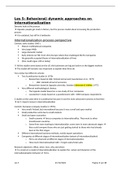Notes de cours
Class notes 5 managing internationalisation
- Établissement
- Katholieke Universiteit Leuven (KU Leuven)
notities van de vijfde les van managing internationalisation waarin zowel de powerpoint als uitleg tijdens de lessen aan bod komen alsook de besproken video case van deze les. notes from the fifth lesson of managing internationalisation covering both the powerpoint and explanations during the le...
[Montrer plus]












